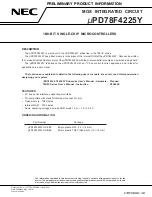
8.4 Installing Peripheral Devices
YASKAWA ELECTRIC
SIEP C710606 44B YASKAWA AC Drive T1000V Technical Manual
301
Pe
ri
ph
er
al
D
evi
c
es
&
Opt
ions
8
◆
Installing a Magnetic Contactor at the Power Supply Side
■
Disconnecting the Power Supply
The drive should be shut off in the case of a fault in external equipment such as braking resistors through use of a
Magnetic Contactor (MC).
NOTICE:
Install a MC on the input side of the drive when the drive should not automatically restart after power loss. To get the full
performance life out of the electrolytic capacitors and circuit relays, refrain from switching the MC more than once every 30 minutes.
Frequent use can damage the drive. Use the drive to stop and start the motor.
NOTICE:
Use a magnetic contactor (MC) to ensure that power to the drive can be completely shut off when necessary. The MC should
be wired so that it opens when a fault output terminal is triggered.
■
Protecting the Braking Resistor or Braking Resistor Unit
Use an MC on the input side of the drive to protect a braking resistor or braking resistor unit from overheat or fire.
WARNING!
Fire Hazard. When using a braking unit, use a thermal relay on the braking resistors and configure a fault contact output
for the braking resistor unit to disconnect drive main power via an input contactor. Inadequate braking circuit protection could result in
death or serious injury by fire from overheating resistors.
◆
Connecting an AC or DC Reactor
AC and DC reactors suppress surges in current and improve the power factor on the input side of the drive.
Use a DC reactor or AC reactor or both:
• To suppress harmonic current or improve the power factor of the power supply.
• When using a phase advancing capacitor switch.
• With a large capacity power supply transformer (over 600 kVA).
Note:
Use an AC or DC reactor when also connecting a thyristor converter (such as a DC drive) to the same power supply system,
regardless of the conditions of the power supply.
■
Connecting an AC Reactor
Figure 8.3
Figure 8.3 Connecting an AC Reactor
■
Connecting a DC Reactor
Ensure the jumper between ter1 and +2 (terminals are jumpered for shipment) is removed when connecting a
DC reactor. The jumper must be installed if no DC reactor is used.
Refer to Connecting an AC Reactor on page 301
for
an example of DC reactor wiring.
Figure 8.4
Figure 8.4 Connecting a DC Reactor
A – Power supply
C – AC reactor
B – MCCB
D – Drive
A – Power supply
C – Drive
B – MCCB
D – DC reactor
B
A
C
D
R/L1
U
V
W
X
Y
Z
S/L2
T/L3
A
C
D
R/L1
+1 +2
B
S/L2
T/L3
















































